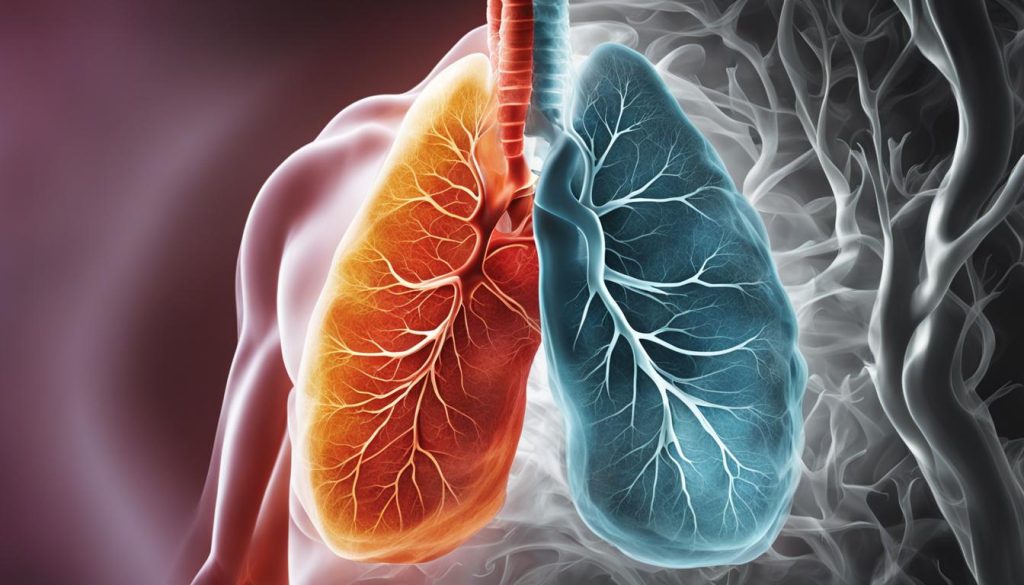Breathing in air pollution, cigarette smoke, and other irritants can damage the lungs and lead to health conditions. Maintaining good lung health is vital for keeping the rest of the body healthy. Lung cleansing techniques may be beneficial for people who smoke, people who are regularly exposed to air pollution, and those with chronic respiratory conditions, such as asthma, chronic obstructive pulmonary disease (COPD), and cystic fibrosis. This article will explore effective methods for naturally removing mucus from the lungs.
How to Remove Mucus from Lungs Naturally?
Steam Therapy for Removing Mucus from Lungs
Steam therapy, also known as steam inhalation, is a natural and effective method for clearing excess mucus from the lungs. By inhaling water vapor, steam therapy can open the airways and help loosen mucus, providing immediate relief and improving breathing for individuals with lung conditions such as COPD.
Steam adds warmth and moisture to the air, which can aid in loosening mucus inside the airways and lungs. This technique is particularly beneficial for individuals who are looking for natural remedies to remove mucus from their lungs.
To incorporate steam therapy into your lung cleansing routine, follow these steps:
- Boil a pot of water or use a humidifier to produce steam.
- Place a towel over your head and lean over the pot of steaming water or position yourself near the humidifier.
- Inhale the steam deeply through your nose for approximately 5-10 minutes.
- Exhale slowly through your mouth to expel the loosened mucus.
- Repeat this process 2-3 times a day, or as needed.
Steam therapy can be enhanced with the addition of essential oils, such as eucalyptus or peppermint oil, which have natural decongestant properties. However, it is essential to consult with a healthcare professional before incorporating essential oils into your steam therapy routine.

Benefits of Steam Therapy for Lung Health
The benefits of steam therapy for lung health include:
- Opening the airways: Inhaling steam helps to dilate the bronchial tubes, allowing for easier breathing.
- Loosening mucus: Steam helps to moisturize and loosen mucus, making it easier to expel from the lungs.
- Relieving congestion: Steam therapy can provide immediate relief from congestion and a stuffy nose, promoting comfortable breathing.
- Reducing inflammation: The warm steam can help soothe irritated airways and reduce lung inflammation.
- Promoting relaxation: Steam therapy can have a calming effect on the respiratory system, promoting relaxation and stress relief.
Remember, steam therapy should be used in conjunction with other natural lung cleansing techniques for optimal results. Consult a healthcare professional for personalized advice and to ensure steam therapy is safe and appropriate for your specific needs.
Controlled Coughing to Reduce Mucus in Lungs
Controlled coughing is an effective technique for loosening excess mucus in the lungs and facilitating its elimination through the airways. By practicing specific steps and employing proper breathing techniques, individuals can successfully cleanse their lungs of mucus. This natural coughing technique can be performed comfortably while seated and involves slow, deliberate inhalation and exhalation, coupled with controlled coughing movements. Implementing controlled coughing can effectively clear the airways, enhance breathing, and reduce mucus build-up in the lungs.
If you’re looking to reduce mucus in your lungs, controlled coughing is a technique worth considering. By gently and intentionally coughing, you can help remove excess mucus and promote better respiratory health. Here’s how to perform controlled coughing:
- Sit in a comfortable position and relax your shoulders.
- Inhale deeply through your nose, taking in as much air as possible.
- Exhale slowly, pushing the air out of your lungs.
- While exhaling, perform a controlled cough by huffing or making a “huh” sound.
- Repeat steps 2-4 multiple times, ensuring that each cough is controlled and deliberate.
Practicing controlled coughing on a regular basis can help improve lung function, reduce mucus congestion, and enhance overall respiratory well-being. Incorporating this natural coughing technique into your routine may contribute to a more comfortable breathing experience and aid in maintaining lung health.
When to Seek Medical Advice
If you have chronic respiratory conditions, such as asthma or chronic obstructive pulmonary disease (COPD), or if you experience any concerning symptoms while practicing controlled coughing, it is important to consult a healthcare professional. They can provide personalized advice and ensure that you are using proper techniques tailored to your specific needs and medical history.

Implementing controlled coughing as part of your daily routine can be highly beneficial for reducing mucus in the lungs naturally. However, it is essential to note that this technique may not be suitable for everyone. If you have any underlying health conditions or concerns, consult with a healthcare professional before incorporating controlled coughing into your respiratory care regimen.
Postural Drainage for Draining Mucus from Lungs
Postural drainage is a technique that can effectively remove mucus from the lungs by utilizing gravity. By positioning the body in various ways, mucus can be drained from the lungs, improving breathing and aiding in the prevention of lung infections.
To perform postural drainage, individuals can lie on their back, sides, or stomach and practice specific breathing patterns. These positions help to target different areas of the lungs, allowing mucus to be directed towards the throat and expelled from the body.
Postural drainage can be particularly beneficial for individuals with conditions such as cystic fibrosis or chronic bronchitis, where excess mucus accumulation in the lungs is a common issue. By regularly practicing postural drainage, mucus can be effectively cleared, reducing the risk of infections and improving overall lung function.
In addition to postural drainage, other techniques such as chest percussion or vibration can be used to enhance the effectiveness of mucus removal. These techniques involve gentle rhythmic tapping or vibration on the chest, which can help loosen and mobilize mucus, making it easier to drain.
Incorporating postural drainage into a comprehensive respiratory care routine can significantly improve lung health and reduce the risk of complications. It is advisable to seek guidance from a healthcare professional or a respiratory therapist to ensure proper technique and maximize the benefits of postural drainage.
Practicing postural drainage as part of a regular lung care routine can help individuals effectively manage mucus buildup, promote lung health, and prevent the onset of respiratory infections.
Exercise for Healthy Lungs
Regular exercise is crucial for maintaining overall health, including lung health. Exercise helps to improve physical and mental health, decrease the risk of many health conditions, and keep the lungs healthy. When a person exercises, their breathing rate increases, leading to a greater supply of oxygen to the muscles and improved circulation.
There are numerous benefits of exercise for lungs. Firstly, exercise strengthens the respiratory muscles, making them more efficient in oxygen exchange. This can improve lung capacity and overall lung function. Secondly, exercise promotes better blood circulation, which helps transport oxygen more effectively throughout the body. This increased oxygen supply is crucial for maintaining healthy lung tissue.
The Benefits of Exercise for Lung Health
Regular physical activity not only improves lung health but also reduces the risk of developing respiratory conditions. Studies have shown that individuals who engage in regular exercise are less likely to develop chronic lung diseases such as asthma, COPD, and lung cancer. In addition, exercise can help manage symptoms for those already living with these conditions.
Exercise also helps to strengthen the immune system, reducing the risk of respiratory infections. By maintaining a healthy weight through exercise, individuals can reduce the strain on their lungs and decrease the likelihood of developing obesity-related respiratory issues.
Furthermore, exercise is beneficial for mental health, reducing stress and anxiety, which can indirectly impact lung health. Stress and anxiety can contribute to shallow breathing and poor lung function. Engaging in regular exercise can alleviate these symptoms, promoting deep and efficient breathing.
Types of Exercises for Healthy Lungs
There are various types of exercises that can improve lung health and strengthen respiratory muscles. Aerobic exercises such as brisk walking, cycling, swimming, and jogging are particularly effective in enhancing lung function. These activities increase heart rate and breathing rate, challenging the lungs to work harder and become more efficient.
Additionally, incorporating strength training exercises can further improve lung health. Resistance exercises like weightlifting and body weight exercises help build muscles, including the respiratory muscles. This leads to improved lung capacity and overall lung function.
Consult a Healthcare Professional
It is important to consult a healthcare professional before starting a new exercise regimen, especially for individuals with chronic lung conditions. They can provide personalized advice and guidance on the most suitable exercises for specific health needs and limitations.
Incorporating regular exercise into a daily routine is a proactive approach to maintaining lung health. By engaging in physical activity, individuals can improve lung function, reduce the risk of respiratory conditions, and promote overall wellbeing.

Conclusion
Removing mucus from the lungs naturally is possible through various techniques. Steam therapy, controlled coughing, postural drainage, and exercise are effective methods that can help clear the airways, improve breathing, and reduce lung inflammation. These natural remedies can be complemented by drinking green tea, consuming anti-inflammatory foods, and using essential oils.
However, it is crucial to consult a healthcare professional for personalized advice and to ensure proper lung health. They can provide guidance on the appropriate techniques and remedies for individual needs. By incorporating these natural lung mucus removal methods into a comprehensive approach to healthcare, individuals can take steps towards maintaining optimal lung health and overall well-being.
Remember, prioritizing lung health is essential for a healthy life. Take action today and explore these natural solutions to support your respiratory health.

